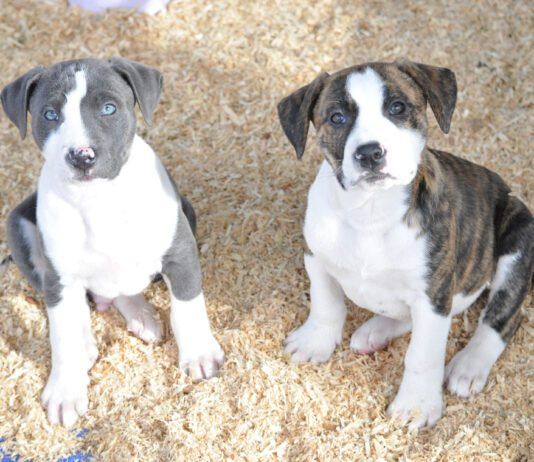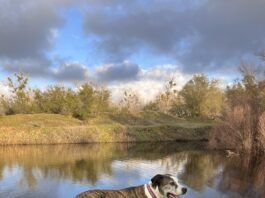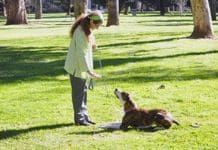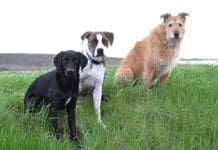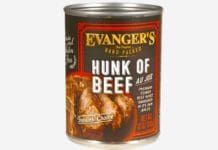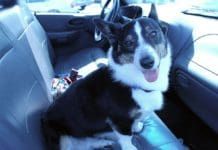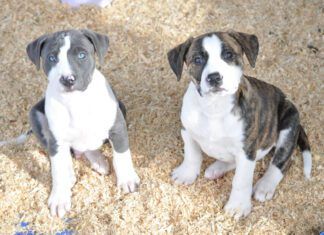Oh, Woody
I recently went on a vacation without dogs, for a whole week. My sister took care of my perfect, nine-year-old dog Otto, but my young adult son took care of my adolescent dog, Woody. It was a better fit because my son is an athlete and runs, and Woody would get enough exercise to keep him out of trouble.About 36 hours after I returned and met with my son and brought Woody home, I awoke to the sound of a dog about to vomit you all know that sound. I jumped out of bed and ran to open the door and encourage the vomiter, who of course turned out to be Woody, to go outside. He lurched over to some tall grass and threw up. Then he went back into the house, climbed onto the couch, and went back to sleep. I went back to bed.I was way too tired to investigate the vomitus until after it was light out, later that morning. Here is what I found!
Don’t Let Them Get Obese!
More and more often, it seems, I see a super fat dog surrendered to the shelter. I always feel sorrier for these dogs than for the thin ones, because we can get a skeletal dog looking pretty healthy in a month's time, but in the shelter environment, an obese dog may not be able to lose an ounce! Caged in a small run, being over-fed...the conditions are likely to make them even fatter! Plus, few people want the panting, exercise-intolerant, unattractive dogs; they end up lingering in our adoption kennels for a long time. And few of them have ever experienced anything like what must feel, in comparison to their former soft lives, like total deprivation - hard time - in the shelter environment.
One dog I've talked about before was this darling Labrador, who was surrendered to my local shelter weighing 110 pounds. By California law, she needed to be spayed before she could be adopted, but the surgery couldn't be scheduled before she lost at least 20 or more pounds; surgery on such an obese dog takes a long time - the fat just floods into the incision and obscures the tissues that need to be cut and sutured - and is considered high risk.
One dog I've talked about before was this darling Labrador, who was surrendered to my local shelter weighing 110 pounds. By California law, she needed to be spayed before she could be adopted, but the surgery couldn't be scheduled before she lost at least 20 or more pounds; surgery on such an obese dog takes a long time - the fat just floods into the incision and obscures the tissues that need to be cut and sutured - and is considered high risk.
My Dog’s Springtime Allergies: RIGHT on Time
In past years, I've discussed my system of keeping a yearly calendar for my dogs that is loaded with notes about their health and behavior. It helped me identify the earliest signs of Otto's springtime allergies, and take proactive management steps to minimize his suffering.
Dog Training Wisdom from Pat Miller
I've worked with Woody a LOT on reducing his reactivity to the sight of strange dogs and people, and he's come a long, long way. If he spots someone (dogs or people or both) that he regards as "strange," he will usually emit a small growl; that's my cue to pay attention and manage the situation BEFORE it's a situation. In the beginning, I would just counter-condition like mad from a safe and sane distance (doing a quick U-turn and exuberant trot off into the opposite direction if need be), and then delivering treats to him in a rapid-fire fashion. The goal is to change how Woody FEELS about seeing strange dogs or people by making it RAIN treats whenever he sees said strange people or dogs; a secondary goal is to get him to look to me when he sees something alarming, so I can give him direction and reassurance that all is well.In the early days of our counter-conditioning sessions, I wasn't looking for any particular behavior from Woody; the point of counter-conditioning is not to (immediately) change the dog's behavior, but to change his emotional response from a negative one to a positive one. Once he's been conditioned to feel happy about the sight of "strange" people or dogs, as evidenced by a quick look at his handler with what Pat calls the "Where's my treat?!" look, changing his behavioral response becomes easy and not so highly charged. In recent months, Woody has improved to the point where I can give the cue "Off!" and he will instantly and happily look away from whatever it is that has him spooked and look at me for the treats.
Why These Dogs are Making Me Sad
For the past three days, anyone who has called me has asked, "What's wrong?" I keep thinking I'm doing a fine job of covering my irritation and emotional upset, and answering the phone the way I always do, but apparently - not.For weeks, since the evacuation of my shelter, I've been fostering a young dog who was brought into the shelter a few days before the evacuation. The people who brought him to the shelter said they found him as a stray. It later developed that someone who saw him in the shelter recognized him as the dog who belonged to the people who surrendered him; they pretended he wasn't their dog when they surrendered him. That happens often enough that no one at the shelter was surprised to learn this. The dog is adorable, but he's got problems - physical and behavioral.I think he's been kept in a crate or small pen his whole life; he has the least amount of muscle tone of any dog I've ever met.
Titer Tests, and Preventing Overvaccination
Every year since I adopted Otto from my local shelter, I have sent out his blood to a lab for a "vaccine titer test." The test I ask for detects circulating antibodies that defend against two canine diseases: distemper and parvovirus. Veterinary immunologists feel that the results of this particular test offers a reliable indication of whether the dog is adequately protected against the diseases he has been vaccinated for, or whether he no longer has a detectible number of antibodies to those diseases in his body.
Are Grain-Free Foods Taking Over the Premium Dry Dog Food Market?
I was in a chain pet supply store the other day, looking for a higher-quality food for some foster dogs from my local shelter who are a little chubby. For this reason, I was looking for a product that was not too high in fat.I was a bit surprised to realize that grain-free foods have sort of taken over the shelves in the section of the store where the higher-quality foods are stocked. Many of the companies whose products appear in the "natural/holistic" or "premium" section seem to offer only grain-free foods. I had to go through several aisles before I found a product from a company that I like offering a food that contained grain and had a lower fat content.
Why I’m Grateful for My Dogs – Again
Yesterday, I had a long list of things that I needed to do and had committed to doing - things for myself, my job, my husband, a friend, and the shelter where I volunteer. The list was so long that just contemplating it made me feel tired.Not even on my list, but in the back of my mind, was the knowledge that the dogs haven't been out for a good long run in days and days. Nine-year-old Otto can cope with that; while he loves going out for off-leash runs, his behavior doesn't really change if he doesn't have that opportunity.But Otto's counter-point is one-year-old Woody, whose behavior gets increasingly gravity-defying with each day that goes by without a run. The carpet runners in my hall start piling up at either end, as he finds he can no longer walk through the house; he has to dash down the hall and slide into the room at either end. He starts greeting guests with airs above the ground. Wooden things (like the redwood bench on my deck) start getting chewed anew.
Canned Dog Food Recall Gives Rise to More Questions Than Answers
On February 3, 2017, the FDA announced that Evanger's Dog & Cat Food had recalled five lots of its canned Hunk of Beef dog food, for a "potential contaminant," pentobarbital. One dog has died after eating the food, and three others were sickened. All four dogs belong to the same family, and ate food from the same can of food. The dog that died was necropsied, and some food from the open can of food was tested. The results: both the dead dog's stomach contents and the open can contained pentobarbital, a drug commonly used to euthanize animals.Given that the Hunk of Beef food - an incomplete diet meant for supplemental or intermittent feeding - contains nothing but beef chunks, Evanger's is blaming its supplier of the beef used in the batch of contaminated food. The company has announced a voluntary recall of that batch of food, as well as four other batches of food produced the same week with beef from the same supplier. The company says it has terminated its relationship with the supplier, despite a 40-year history of doing business together.
Oroville Dam Case Study: How Evacuating People And Animals Early and Often Can Save...
In the winter of 1997, the town where I live now, Oroville, California, had a big flood. I didn't live here then. But that year, the Feather River, which (usually) flows tamely right through my town, was threatening to massively flood the town. There is a dirt levee that separates the river from the main streets, and it seems like an historic artifact most of the time - a thing that was built by pioneers to try to keep the Feather from flooding the town again and again. It seems quaint now, because since 1968, the town has been more significantly protected by the Oroville Dam, with a huge reservoir (Lake Oroville) behind it - the combination that meters out the Feather at a safe and sane rate, protecting the town and much of the Sacramento Valley below from flooding. But with truly historic rainfall, like in 1997, the operators of the dam can't help but let out so much water that the river swells to capacity, and suddenly our old historic levee is important once again, holding back the Feather from flooding Oroville.In 1997, with the Oroville Dam letting out maximum quantities of water, and the Feather crazily high, the levee started seeping. County officials called for an immediate evacuation of Oroville. If the levee burst, they said, the town would be covered with 12 feet of water.The local animal shelter lies about a mile and a half from the river, in the prehistoric flood plain of the Feather. Wild-eyed police officers gave the then-director of the shelter 15 minutes to get her staff and herself out of the shelter.
Locked In!
At risk of making sure that the friend who visited me last week never comes to visit me again, this week's blog post is ALSO going to be inspired by her dog. (Last week, I wrote about how she never leaves her dog in the car - ever! - a practice that I personally find admirable but impractical for me, personally.)My friend's 10-month-old dog and my 14-month-old dog, Woody, got along beautifully - if you can call it beautiful when two adolescent males are rolling around in a wrestling ball that takes them over, under, around, and through most people and obstacles in their path. They loved, loved, loved playing the same sort of tug/chase/face-biting/wrestling games, and could go for hours! But when we made plans to leave the house and visit some places where the two youngsters couldn't accompany us, we mutually decided to separate the boys so neither could get hurt or overwhelmed by the other while we were out. It was time for a play break! The question was, where would we leave my friend's dog?
Would You Leave Your Dog In the Car?
Yesterday, I met a friend in a town about halfway between her house and my house, which are about three hours apart. We both had things to do/people to visit in that midway city, and then she - and her darling, 30-pound moppish-mixed breed dog - were going to follow me home and spend a few days visiting. We met outside a Whole Foods store/restaurant, and I proposed we go in and eat lunch before driving the rest of the way to my house. My friend said, "Can we take turns going in and selecting our food? I don't leave my dog in the car." My mind boggled. If it was hot (or even warm) or freezing out, I would immediately understand, but it was about 50 degrees - a pretty much perfect dog-in-the-car temperature, in my view. So I had to ask, what's up with that? I had a foster dog chew through the front seat belts in my car once; was it about separation anxiety, or something?


